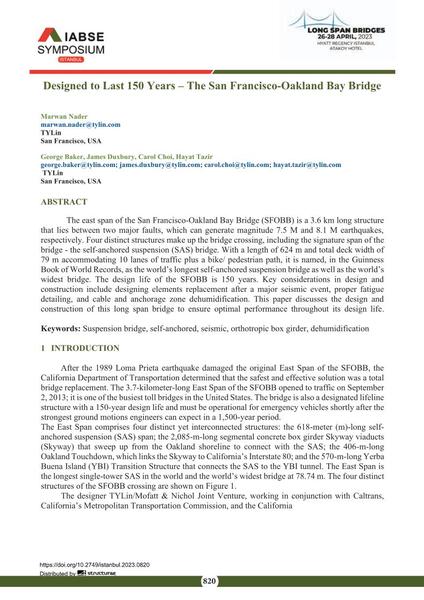Designed to Last 150 Years – The San Francisco-Oakland Bay Bridge

|
|
|||||||||||
Détails bibliographiques
| Auteur(s): |
Marwan Nader
(TYLin, San Francisco, USA)
George Baker (TYLin, San Francisco, USA) James Duxbury (TYLin, San Francisco, USA) Carol Choi (TYLin, San Francisco, USA) Hayat Tazir (TYLin, San Francisco, USA) |
||||
|---|---|---|---|---|---|
| Médium: | papier de conférence | ||||
| Langue(s): | anglais | ||||
| Conférence: | IABSE Symposium: Long Span Bridges, Istanbul, Turkey, 26-28 April 2023 | ||||
| Publié dans: | IABSE Symposium Istanbul 2023 | ||||
|
|||||
| Page(s): | 820-827 | ||||
| Nombre total de pages (du PDF): | 8 | ||||
| Année: | 2023 | ||||
| DOI: | 10.2749/istanbul.2023.0820 | ||||
| Abstrait: |
The east span of the San Francisco-Oakland Bay Bridge (SFOBB) is a 3.6 km long structure that lies between two major faults, which can generate magnitude 7.5 M and 8.1 M earthquakes, respectively. Four distinct structures make up the bridge crossing, including the signature span of the bridge — the self-anchored suspension (SAS) bridge. With a length of 624 m and total deck width of 79 m accommodating 10 lanes of traffic plus a bike/ pedestrian path, it is named, in the Guinness Book of World Records, as the world’s longest self-anchored suspension bridge as well as the world’s widest bridge. The design life of the SFOBB is 150 years. Key considerations in design and construction include designing elements replacement after a major seismic event, proper fatigue detailing, and cable and anchorage zone dehumidification. This paper discusses the design and construction of this long span bridge to ensure optimal performance throughout its design life. |
||||
| Mots-clé: |
pont suspendu
|
||||
